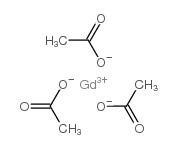10138-52-0
| Name | gadolinium trichloride |
|---|---|
| Synonyms |
trichlorogadolinium
EINECS 233-386-6 Gadolinium(Iii) Chloride,Ultra Dry,Reo) Gadolinium(III) chloride MFCD00011024 |
| Description | Gadolinium chloride is a specific calcium-sensing receptor (CaSR) agonist. Gadolinium chloride can be used for the research of cardiovascular disease[1]. |
|---|---|
| Related Catalog | |
| Target |
CaSR[1] |
| In Vitro | Gadolinium chloride (30 μM; 15 minutes; H9c2 cells) results in increased Bax expression and caspase-3 activation, and decreased Bcl-2 expression in CsA-induced cells[1]. In vitro, GdCl3, a CaSR agonist, has been shown to promote the apoptosis of myocardial cells, which increases ERK1/2 phosphorylation and activates caspase-3[1]. Western Blot Analysis[1] Cell Line: H9c2 cells Concentration: 30 μM Incubation Time: 15 minutes Result: Resulted in increased Bax expression and caspase-3 activation, and decreased Bcl-2 expression in CsA-induced cells. |
| References |
| Density | 4.52 |
|---|---|
| Boiling Point | 1580ºC |
| Melting Point | 609ºC |
| Molecular Formula | Cl3Gd |
| Molecular Weight | 263.60900 |
| Exact Mass | 262.83100 |
| LogP | 2.06850 |
| Vapour Pressure | 33900mmHg at 25°C |
CHEMICAL IDENTIFICATION
HEALTH HAZARD DATAACUTE TOXICITY DATA
|
| Symbol |

GHS07 |
|---|---|
| Signal Word | Warning |
| Hazard Statements | H315 |
| Precautionary Statements | P305 + P351 + P338 |
| Personal Protective Equipment | dust mask type N95 (US);Eyeshields;Gloves |
| Hazard Codes | Xi: Irritant; |
| Risk Phrases | R38 |
| Safety Phrases | 36/37 |
| RIDADR | NONH for all modes of transport |
| WGK Germany | 3 |
| RTECS | ZC0230000 |
|
~% 
10138-52-0 |
| Literature: Thermochimica Acta, , vol. 320, # 1-2 p. 1 - 7 |
| Precursor 1 | |
|---|---|
| DownStream 3 | |





